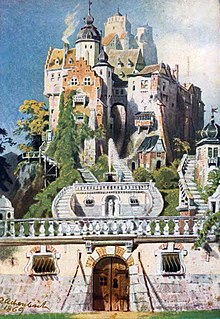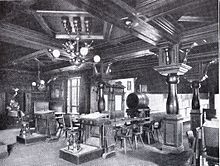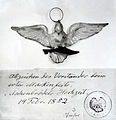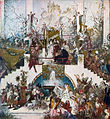Malkasten-Redoute


The Malkasten-Redoute was an annual masked ball for the Düsseldorf Carnival in the Malkasten artists' association in Düsseldorf .
history
The artists' association Malkasten (KVM) was founded in Düsseldorf in 1848 as a social association between artists from the Düsseldorf School of Painting . After the association had made the decision to also accept non-artists, it and its festivals quickly advanced to become a social center of the city, especially during the times of the Düsseldorf Carnival . In addition to the "Awakening of Hoppeditz " and the carnival parade, the KVM mask festival , the redoubt , was a highlight of the annual carnival and the central event on Carnival Saturday. What the Rose Monday procession was for Cologne, the masked balls on Carnival Saturday represented in Düsseldorf - at least that is how the reporters in the local newspapers around 1900 were happy to point it out. The Malkasten-Redoute on Saturday was followed by Sunday, when all the children of the better classes in costumes, presented a very colorful picture with cot and gun, then Monday and Tuesday with the masked crowd in all the streets that lasted until Ash Wednesday morning. Then the carnival came to an end when the last, often drunk, mask-wearers met pious churchgoers who wore the ash cross on their foreheads.
The city has been one of the centers of the democratic movement and protest in Prussia since the pre- March period . In this context, the carnival was suspected by the authorities of being used by Rhenish " Musspussians " for anti-Prussian and revolutionary rallies. During the German Revolution , in the course of which Düsseldorf citizens had formed a revolutionary vigilante group, the authorities initially forbade any public elevator for the carnival days in February 1849. But shortly before the start of the street carnival, on January 23, 1849, this ban was lifted again so that the folk festival could continue as usual.
Close personal ties developed between the Düsseldorf Carnival and the city's artists. On November 11, 1849, the General Association of Carnival Friends (AVdK) awarded the certificate of honorary membership to the KVM and asked them to cooperate. A connection between the members of the Malkastens and the oldest carnival club in Düsseldorf, the AVdK, founded in 1829, had existed since 1848, the year the KVM was founded. From 1846 to 1847 the painter Adolph Schroedter was President of the AVdK. Since it was founded in 1848, he has also been a member of the KVM. Another very active member of the KVM, the painter Karl Hoff , was President of the AVdK from 1870 to 1872. The painter, cartoonist and writer Carl Maria Seyppel , a president of AVdK and KVM, 1889 founded the "Committee for the organization of an artistic Carnival Monday procession ."
One of the first mask festivals took place in February 1852 under the theme "Cinderella's Wedding" in the Geisler Hall , from 1865 the Kaisersaal on Flinger Steinweg was the venue. Until 1867, the KVM did not have its own club building for larger events. In the restaurant, previously known as Becker's garden bar , there was a large hall. In this hall, already called Tonhalle back then, the number of spectators in 1850 was almost 1,000. In 1863 the city acquired the restaurant and the Tonhalle was until 1914 a masquerade of the paint box on Carnival Saturday.
The KVM mask festivals were determined in their scenic arrangements and dramatic performances by the theme, the equipment and the course of the festival. The stage play could either be initiated or concluded by a pageant in which participants and spectators took part. In order to achieve the desired effect on the train, the type of costume was usually specified. Since the artist festivals - historical pageants, mask festivals, revue, cabaret or theater - required a large amount of creative preparation, the artists were particularly involved. They made designs for the costumes and decorations for the performances. For example, Wilhelm Camphausen designed historical costumes for “Cinderella’s Wedding” , which were published as templates. They were also binding for the clothing of the participants and spectators, including Robert Schumann . Invitation cards, posters and leaflet announcements were also designed by the artists. The actual spectacle was documented in paintings and later in photographs. There was always a dress rehearsal beforehand . After the big Malkasten-Redoute, the gentlemen found their cheerful end in the bowling alley.
Due to their masking, the guests were not restricted to their role as spectators, but made a significant contribution to the artistic framework and success of the event. The masquerade was usually accompanied by an introductory or concluding pageant of the costumed participants and spectators. Just the acquisition of the elaborately designed admission ticket allowed for the mood of the event and was able to stimulate the imagination. The experience of community in the festival and procession made it possible to include the festival participants in the events and to transport them into the world of what is represented. In the course of a festival, the self-irony of the artists became more and more apparent. It broke with the aesthetically designed illusion on stage and thus enabled the change to a relaxed festive mood. Like in 1896 in “Die Narrenburg” in front of a decoration by Andreas Achenbach , who represented the prince, the court chancellor gave a speech from the throne , which equated the artist festival with art.
The rather high entrance fee was the main source of income for the paint box, which otherwise could not have existed. The members of the artists' association only had to pay 3 marks in the 1880s, all the others and especially the many foreigners paid 15 to 20 marks entry. The surpluses from the carnival redoubt were used to finance other KVM events.
In the form of the festival with pageant as an integral part of the carnival event, until the beginning of the 1870s, the redoubts of the KVM mainly featured episodes from the world of fairy tales. Towards the end of the 19th century, topics arose that could be associated with certain historical events, such as "The Hussites before Naumburg 1432" and "Triumph of the Hansa". They also reflected individual art-historically significant epochs, arranged around artist personalities such as Dürer or Rubens . The Gründerzeit redoubt was also able to summarize historical processes. The development of the Malkasten Redoute was closely related to the general spread of historical pageants in the second half of the 19th century.
In 1878, Prince Wilhelm, who later became Emperor Wilhelm II , who was studying in Bonn at the time, and his entourage visited the “Gypsy Festival” redoubt at the Malkasten artists' association in Düsseldorf.
1999 showed City Museum Bonn in Ernst-Moritz-Arndt-Haus , the exhibition festivals to honor and a pleasure. Artist festivals of the 19th and early 20th centuries .
The carnival celebrations held in this special elaborate form, called Redoute , were celebrated until before the Second World War. The Malkasten house was badly damaged in the war and then rebuilt. Nonetheless, the Malkasten artists' association celebrates a lavish "mask reception" and Ash Wednesday Hoppeditz funeral with a traditional fish meal every year .
Poster legend and history of the Rhine , for Redoute 1872, by Caspar Scheuren
Paint box redoubt "Holland's heyday", 1912. Set with cityscape of Amsterdam by Georg Hacker . Author of the festival Eduard Daelen .
Redoubt of the Malkasten in Carnival (selection)
- 1852, February 14: "Cinderella's Wedding"
- 1857, January 18th and 19th: "The Fools of Count von der Lipp, or the overcome drumbeater"
- 1867, March 2nd: "Natural history of the beetles"
- 1868, February 22nd: Redoubt
- 1869, February 6th: "The Narrenburg"
- 1872, February 10: "Legend and History of the Rhine"
- 1878, March 2nd: "Gypsy Festival"
- 1879, February 22nd: "Sleeping Beauty"
- 1880, February 7th: "Triumph of Fashion"
- 1881, February 26: "Alt Düsseldorf"
- 1885, February 14th: "Paint box colony on the Congo"
- 1887, February 19th: "A wedding fairy tale"
- 1888, February 11: “A Winter Night's Dream”; Head: Wilhelm Simmler , Carl Gehrts ; Director: Max Volkhart
- 1889, March 2nd: "Albrecht Dürer in Venice"
- 1890 February 15th: "Artists' dreams"
- 1891, February 7th: " Stange’s travel company to Egypt"
- 1893, February 11th: "A party with Peter Paul Rubens"
- 1896, February 15th: "A wedding on the moon"
- 1898, February 19: "The Hussites before Naumburg 1432"
- 1899, February 11: "A Flower Festival"
- 1900, February 24th: "Triumph of the Hansa"
- 1901, February 16: "The retrieval of Jacobe von Baden"
- 1904, February 13th: "The engagement of ... the knight Delorsky to Fraulein Kunigunde"
- 1914, February 21: "Love Magic"
- 1912, February 17th: "Holland's heyday"
- 1927, February 26: "In the kingdom of the Buddha"
- 1931, February 14th: "Well, what?"
- 1934, February 10th: "Outrageous in the paint box"
- 1938, February 26th: “Düsseldorf 650 years ago. ... "
literature
- Ingrid Bodsch, edited by Sabine Schroten: Celebrations for honor and pleasure. Artist festivals of the 19th and early 20th centuries. Bonn, 1998, ISBN 3-931878-08-2
- Carl Murdfield: From the chronicle of the paint box
- Christina Frohn: Carnival Cologne, Düsseldorf and Aachen 1823 - 1914 (dissertation)
- Eduard Daelen: Holland's heyday . Festival for the Malkasten Redoute, Saturday, February 17, 1912, Bagel, Düsseldorf, 1912
- Alfons Houben: From the Düsseldorfer Karnevalsgeschichte, in: Malkastenblätter 33 (1991), pp. 1-4
Web links
- Artist festivals of the 19th and early 20th centuries
- Artists' association Malkasten: Stars in the sky of the carnival , in Carnival Lexicon and media archive of the Comitee Düsseldorfer Carneval eV, accessed on July 4, 2016
Individual evidence
- ↑ Irene Markowitz : The Malkastengarten . In: Wieland Koenig (Ed.): Düsseldorfer Gartenlust . Catalog, Stadtmuseum Landeshauptstadt Düsseldorf, Düsseldorf 1987, p. 68
- ↑ Frank Wintgens: Living with the Past. Festivals and celebrations in Düsseldorf. 1945–1955 . Publications from the Düsseldorf City Archives, Volume 6, ISBN 978-3-926490-05-6 , Düsseldorf 1996, pp. 27, 61, 188
- ^ Report on the Malkasten redoubt from 1912 in: Düsseldorfer Tageblatt of February 20, 1912
- ↑ Volker Frech: Living Images and Music using the Example of Düsseldorf Culture , diplom.de, 1999, ISBN 3-8386-3062-9
- ↑ Decoration sketch for the wedding fairy tale 1887 by Carl Gehrts
- ^ Costumes from the 16th and 17th centuries, as well as from the Middle Ages, lithographs Camphausen
- ^ Poster from 1890 by Johannes Gehrts
- ^ Exhibition review of the Stadtmuseum from 1991 to 1999
- ↑ Pictures: Mask reception with Prince Lothar, his Venetia Ute and her entourage, 2009 , on the malkasten.org archive, accessed on August 4, 2016
- ↑ Ash Wednesday: Hoppeditz ceremony and fish meal in the theater hall, 2016 , from the malkasten.org archive, accessed on August 4, 2016
- ↑ Poster “The fools of Count von der Lipp, or the drumbeater that has been overcome”, carnival fluctuation in 3 acts
- ^ Eduard Daelen : Malkastenredoute. A wedding fairy tale . In: The art for everyone: painting, sculpture, graphics, architecture . Issue 11 of March 1, 1887, pp. 169–171
- ↑ Program booklet “A Winter Night's Dream” Mask Festival 1888
- ^ From the festival "Holland's heyday" of the Düsseldorf Malkasten-Redoute , in Rhine and Düssel (No. 9) on March 2, 1912








